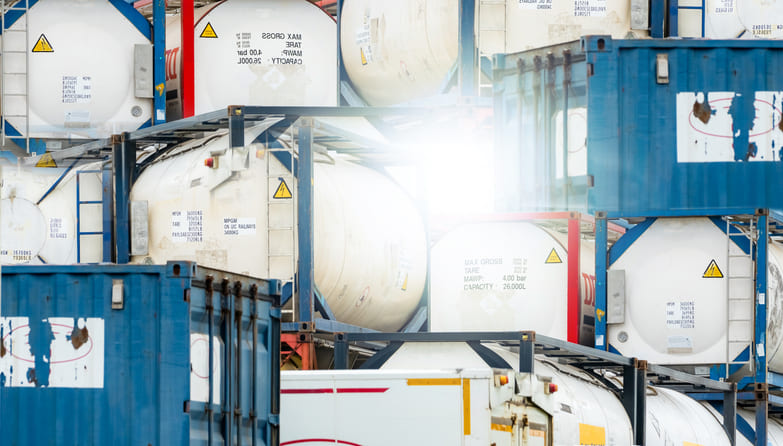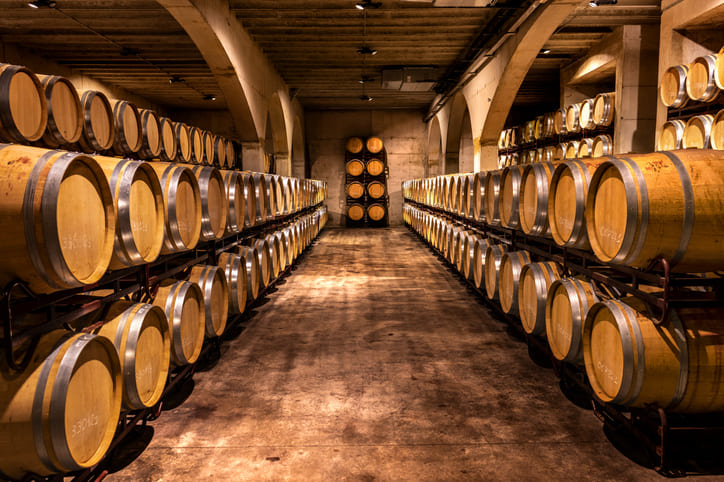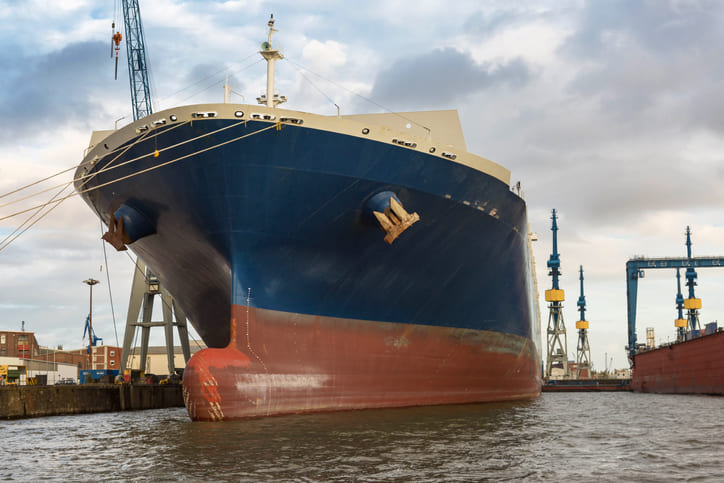Share this post
The only guide to road freight for wine importers
No matter where you are sourcing your wine, road freight is the start and end of any journey. It’s the go-to option for transporting wine short distances, but it’s also a component of every multimodal cargo journey by land, sea, or air. It’s the most essential mode of transport, but how much do you really know about road freight?
What is freight transport by road?
Road freight means using trucks, vans, or other vehicles to move wine from one location to another via a road network. Commercial road freight is done by trucking companies, often referred to as a carrier. They own the vehicle and do the actual transport. The booking placed with the carrier can be made directly though in most cases it is managed by logistics companies or logistics providers like Hillebrand Gori, which is one of the best companies to transport wine. Why? Because the road freight element is part of that bigger logistics journey and requires the coordination of documentation and customs, as well as a constant flow of information for pick-up and delivery.
Road freight allows you to transport your wine from wineries to warehouses, retailers, and end consumers. Whether it be a Full Truck Load, part of an LCL service or Last Mile Delivery.
A brief history of road freight
It’s a good bet that wine has been delivered by road freight since people first domesticated horses and invented wheels around 4 to 5,000 years ago. Carts and chariots pulled by horses could deliver loads much bigger and heavier than had ever been seen before.
Road freight really got going in ancient Rome, where roads, such as the famous Via Appia, helped spread wine and viticulture to cities and ports throughout the empire.
Road freight didn’t change much until the late 19th Century, when horseless carriages first appeared. These primitive motorized vehicles were powered by the internal combustion engine, and it didn’t take long before people started using them to deliver products like wine.
Road freight as we know it, really became possible after John Boyd Dunlop invented the pneumatic tire in 1888 and Edgar Purnell Hooley’s introduction of smooth Tarmacked roads in 1902.
Then, Malcom McLean, a trucking entrepreneur from North Carolina, changed the face of road freight forever when he developed the intermodal shipping container in the 1950s. This meant wine could be packed into one container suitable for truck or cargo ship and stay there until it reached its destination, causing a revolution in freight handling.
Today, 38.9 million trucks move roughly 72.2% of the freight in the US. In Europe, 6.2 million trucks and 29 million vans handle three-quarters of inland freight.
When can you use road freight?
Road freight using vans or trucks is often the easiest and fastest way to move wine for national distribution, involving short and medium-distance journeys. This includes pre-carriage or on-carriage between wineries, warehouses, ports, railway stations, airports, and retailers.
Road freight is also common across borders within densely populated regions, such as Europe or the United States.
What are the advantages of road freight?
The primary advantage of road freight is that nearly all destinations for wine can be accessed by road at some point in their journey. Ships stop at ports, planes stop at airports and trains stop at terminals. This is why road freight is the most important transport mode as it can manage a journey as a stand alone transport mode or as part of a bigger multimodal supply chain.
This allows for door-to-door delivery. Wine can be sent directly from the winery to its destination, and in some cases, without the need for any other mode of transport.
The near-universal nature of road infrastructure also makes it easier to access new markets and reach a diverse variety of customers.
Let’s look at the other advantages of road freight:
It’s fast
Compared to other modes of transport,you don’t need to book a space on a road to get your truck moving. Plus, road freight needs less documentation if you don't cross borders with the shipment you're carrying. This makes it possible to move beverages like wine swiftly on short and medium-distance routes. For example, you can ship a full trailer of wine from an Italian winery to the UK in just 3 days. Rapid transit reduces the chances of spoilage and ensures your wine arrives at its destination in peak condition.
It’s accessible
In most countries, access to trucks via trucking companies is easy. Especially with the help of a freight forwarder who manages the entire process. There are several options too depending on the volume of wine you need to move - FCL and LCL. Economies of scale can be further explored by consolidating wine shipments from different suppliers in a nearby location and transporting them together. It’s what is known as a consolidation on wheels. The truck you book essentially drives from one supplier to the next, adding pallets at each stop, before taking them to your delivery point.
This makes road freight a cost-effective way of shipping small volumes of wine, especially when Less Than Truckload (LTL) options are available (see below for more information).
It’s flexible
Because the road system goes almost everywhere, road freight allows unmatched flexibility in terms of routes and schedules. You don’t need to wait for a departure time for example. Once your truck is loaded, off it goes!
Modern technology means routes can be planned in advance to take into account weather and traffic conditions and to maximize fuel efficiency. However, if something comes up on route, like a delay, it’s relatively easy to change course. It also allows for wine to be shipped at any time at short notice.
It allows for intermodal transport
Road freight plays a part in intermodal transport. Trucks can be driven fully loaded onto ships as part of a Ro-Ro service, or have their containers quickly removed and loaded by cranes onto trains or vessels as part of a Lo-Lo service.
It allows for temperature control
Wine is a temperature-sensitive product that needs special care during transportation. Road freight allows for your wine to be sent in a temperature-controlled environment using solutions such as insulation liners or refrigerated vehicles.
Hillebrand Gori insulation liners are available for pallets, or containers, and are specifically designed in house to eliminate 80% to 90% of thermal shocks. It’s the only liner with a breathable membrane that allows moisture to escape, keeping the humidity level around 70%. Our insulation liners will also protect your beverages from cross contamination and bad odors, so the quality of your wine is preserved throughout its journey.
What are the disadvantages of road freight?
Ok, so you’ve seen the best aspects of road freight, but what else do you need to know? Let’s look at the downsides of shipping wine by truck or van.
It doesn’t go the distance
Trucks are usually faster, but with long distances, rail freight can work out as a cheaper and greener alternative over land.
It’s not the greenest choice
Road freight is not the most environmentally friendly way of transporting wine. It’s responsible for 53 percent of global CO2 emissions by trade-related transport.
Space can be limited
The carrying capacity of trucks is limited, so it’s not always the best option for moving large volumes of wine long distances.
Accidents happen
Traffic collisions are common and can sometimes put drivers at risk of injury and shipments can be damaged.
It’s sometimes unavailable
In some countries, the road freight industry has been under pressure as there are not enough drivers to meet demand. The increase in e-commerce has also stretched the industry’s resources.
What container options are available with road freight?
You can move wine by road freight in bottles or in bulk. If you’re moving bottles, you can choose between Full Truck Load (FTL) or Less Than Truckload (LTL). If you’re transporting in bulk, then you have the option of flexitanks or ISO tank containers.
FTL
FTL, like a Full Container Load (FCL) in sea freight, is your go-to option when the volume of wine you want to move is enough to fill an entire truck. With an FTL shipment, the wine remains in the truck throughout the journey.
LTL
As with Less than Container Load (LCL), LTL lets you send volumes of wine as small as a single pallet. Your wine will be consolidated with beverage shipments from other shippers to fill the truck. As the cost of the service is shared by each shipper, you only pay for the space you need.
Flexitanks
Hillebrand Gori’s food-grade flexitanks are designed in collaboration with wine experts to preserve the quality of your wine when shipped in bulk. They are made from 100% recyclable material and include a protective barrier, that safeguards every drop from the risks of oxygen ingress and taint compounds. They also come with climate control options.
ISO tanks
Our clean and sterile ISO tanks allow you to deliver your bulk beverages cost-effectively, reliably, and safely in optimum condition. Their stainless steel construction means they are insulated, so your wine remains at a stable temperature from pick up to drop off.
The human factor in road freight
At Hillebrand Gori, we understand that the biggest role in guaranteeing a successful delivery is played by the driver. So, we adopted a vehicle and driver platform called Samsara. The software ensures vehicles are driven safely and helps drivers improve their skills. It also monitors the environment inside the truck and sends real-time alerts if temperatures change too much.
Whether you’re shipping a pallet or a container full of wine, when it comes to road freight, look for a freight forwarder like Hillebrand Gori that offers secure, temperature-controlled warehouse facilities and a dedicated fleet of refrigerated trucks and delivery vans.
With us, you can enjoy real-time order tracking and see where your order is on the driver’s scheduled route. Deliveries are handled by uniformed personnel, and you will receive a photo confirmation of the delivery at its destination.
Here at Hillebrand Gori, we go the extra mile to ensure your wine is protected at every stage of the journey.
Contact us today for more information about our wine shipping solutions and a customized quote.
Road freight refers to transporting products by road, typically using trucks and delivery vans. This is a common method for moving products locally or over short distances.
The three types of freight are air, sea, and land. Each type has its own advantages and disadvantages depending on the distance, urgency, and nature of the products shipped.
Rail freight uses trains to transport goods, while road freight uses trucks and delivery vans. Companies often use rail freight for mid-distance transport, while local and regional shipments rely on road freight.
As technology and consumer demands evolve, road freight will significantly change. One prediction is the increased use of electric and autonomous vehicles, which can improve efficiency and reduce carbon emissions.
How can we help your business grow?
.png?sfvrsn=dc2a7a4d_4)
.png?sfvrsn=898c2b36_1)



